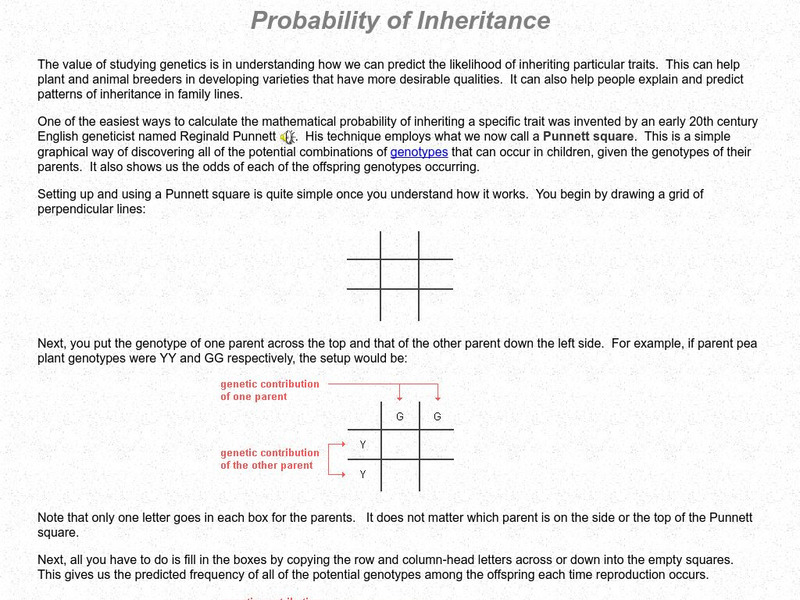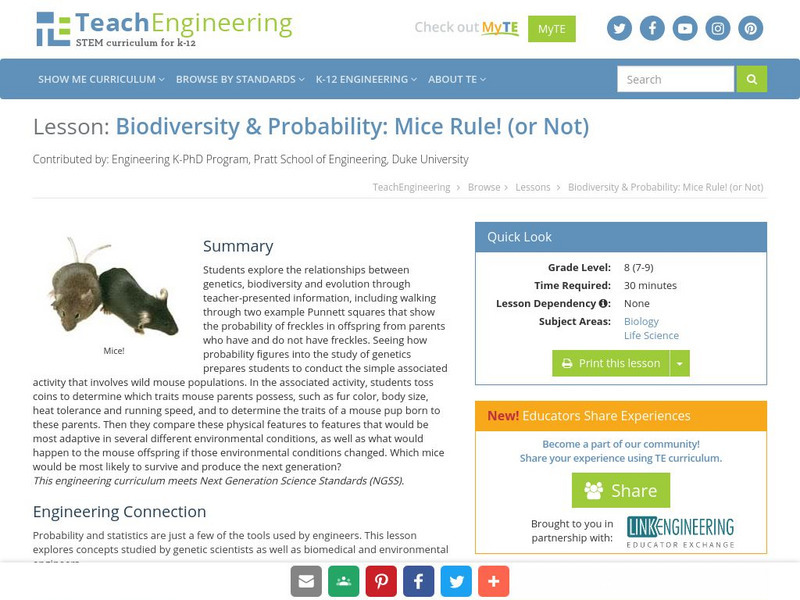Science Buddies
Science Buddies: Pedigree Analysis: A Family Tree of Traits
Some characteristics, like the shape of your hairline, whether your earlobes are attached or detached, and whether or not you have freckles are inherited from your parents. In this science project you will learn about Mendelian traits,...
Palomar Community College District
Probability of Inheritance
A great supplement to help introduce Punnett Squares. It tells how to set them up and how to use them correctly. A sample quiz is offered and feedback is given to help with understanding why an answer is correct or not.
TeachEngineering
Teach Engineering: Mice Rule! (Or Not)
Students explore the relationships between genetics, biodiversity, and evolution through a simple activity involving hypothetical wild mouse populations. First, students toss coins to determine what traits a set of mouse parents...
University of Hamburg
University of Hamburg: Deviations From Mendelian Laws And: What Is the Meaning of Dominance?
Upper level discussion of several of Mendel's experiments and laws.
Concord Consortium
Biologica: Web Lab, Mendel's Peas
At this site see an online visual of meiosis, fertilization, and inheritance and play a game.
Open Curriculum
Open Curriculum: Mendelian Inheritance
Students use this article to identify how probability is used to predict outcomes of genetic crosses.
Other
Your Doctor: Sickle Cell Anemia (In Arabic)
Photos of slides and genetics charts accompany the text and explain the differences between sickle cell train vs. sickle cell anemia, symptoms of sickle cell disease, secondary diseases/conditions associated with sickle cell, mechanism...
Texas Instruments
Texas Instruments: Numb3 Rs: All in the Family
Based off of the hit television show NUMB3RS, this lesson shows students the scientific reasoning behind the societal taboo of incest. Students complete a Punnett square to determine the chances of an offspring inheriting two recessive...
Alabama Learning Exchange
Alex: Sponge Bob Round Pants? What's the Chance?
What are the chances of SpongeBob having kids with round pants? Working in cooperative learning groups, young scholars explore the concept of probability. Using interactive websites, students explore the possibilities of an organism...
University of Arizona
University of Arizona: Dihybrid Problem Set
This site is provided by the University of Arizona and it gives great information on the subject. Good collection of dihybrid crosses which exemplify the issue of independent assortment. Work these once you think you've mastered th concept.
Other
North Dakota State Univ.: Mendel's Law of Ind. Assort.
Mendel's second law and how he arrived at it through his experiments. Includes vocabulary and examples.
Other
Personal Site / Mendels Discoveries
This personal site gives the seven characteristics that Mendel observed and a fairly large background to what Mendel saw and interpreted.
Other
North Dakota State: Mendel's First Law (Law of Segregation)
This resource explains Mendel's first law (Law of Segregation) in detail. Includes Mendel's original experiments with results and conclusions.
Other
North Dakota State Univ./mendel's Law of Ind. Asstort.
Good description of Mendel's findings and his second major principle.
Other
North Dakota State Univ.: Detecting and Measuring Linkage
A good site to establish what is meant by gene linkage and sex-linkage.
TeachEngineering
Teach Engineering: The Benefits of Biodiversity
First, students toss coins to determine what traits a set of mouse parents possess, such as fur color, body size, heat tolerance, and running speed. Next they use coin tossing to determine the traits a mouse pup born to these parents...
Science Buddies
Science Buddies: Neanderthals, Orangutans, Lemurs & You; A Primate Reunion
You have probably seen figures showing how human beings are related to chimpanzees, gorillas, and other primates. In this genomics science fair project, you will use bioinformatics tools to generate your own primate family tree.
University of Maryland
Univ. Of Maryland Baltimore Cty/biology Century
Historical perspective on Mendel's contribution. Spends a little time setting up what the current beliefs of Mendel's day were and how he changed things with what he did.
Palomar Community College District
Waynes Word: Multiple Gene (Polygenic) Inheritance
Explains and gives examples of polygenic inheritance.
TED Talks
Ted: Ted Ed: Why Are Some People Left Handed?
Today, about one-tenth of the world's population are southpaws. Why are such a small proportion of people left-handed -- and why does the trait exist in the first place? The following video investigates how the uneven ratio of lefties...
Other
Stat Soft: Statistics Glossary
Dozens of statistical terms are defined and illustrated in this glossary.
ClassFlow
Class Flow: Natural Selection and Heredity
[Free Registration/Login Required] Students engage in the concept of natural selection and further their understanding of diversity and relatedness within the living world. Inquiries into evolution explain the ways in which natural...
Other popular searches
- Genetics Probability
- Genetics Probability Penny
- Biology Genetics Probability
- Genetics Probability Coin
- Genetics and Probability



